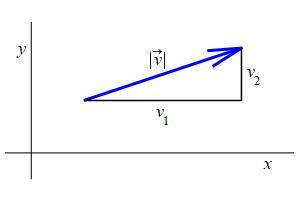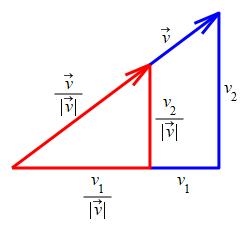5. Vectors
a. Definition, Magnitude and Direction
3. Magnitude
The length or magnitude of a vector \(\vec v=\left\langle v_1,v_2\right\rangle\), denoted by \(|\vec v|\), is defined to be the distance from its tail to its tip. By the Pythagorean Theorem, this is: \[ |\vec v|=\sqrt{(v_1)^2+(v_2)^2} \]

Find the length of the vector \(\left\langle 5,-1 \right\rangle\).
\(|\left\langle5,-1\right\rangle|=\sqrt{5^2+(-1)^2}=\sqrt{26}\)
Notice that we use vertical bars around the vector to denote its length just like the vertical bars that denote an absolute value. You must determine from the context which is which. If there is a number inside the bars, it's an absolute value. If there is a vector inside the bars, it's a length.
Find the length of the vector \(\vec a=\left\langle-5,12 \right\rangle\)
You will be able to do the square root.
\(|\vec a|=13\)
\[ |\vec a|=\sqrt{(-5)^2+12^2}=\sqrt{25+144}=\sqrt{169}=13 \]
Unit Vectors
A unit vector is a vector whose magnitude is \(1\) (unity).
Which of the following are unit vectors?
\(\left\langle 4,-3 \right\rangle\qquad\) \(\left\langle .6,.8 \right\rangle\qquad\) \(\left\langle \dfrac{5}{13},-\dfrac{12}{13} \right\rangle\qquad\) \(\left\langle-\,\dfrac{\sqrt{3}}{2},\dfrac{1}{2} \right\rangle\)
To emphasize that a vector is a unit vector, we will put a hat over its name instead of an arrow. Thus \(\hat u\) is a unit vector whereas \(\vec u\) may or may not be.
Given an arbitrary vector \(\vec v=\left\langle v_1,v_2 \right\rangle\), we can always construct a unit vector which points in the same direction. It is: \[ \hat v =\left\langle\dfrac{v_1}{|\vec v|},\dfrac{v_2}{|\vec v|}\right\rangle \]
We need to verify that \(\hat{v}\) is in fact a unit vector and does point in the same direction as \(\vec v\). We first compute its length: \[\begin{aligned} |\hat v| &=\sqrt{\left(\dfrac{v_1}{|\vec v|}\right)^2 +\left(\dfrac{v_2}{|\vec v|}\right)^2} \\ &=\sqrt{\dfrac{ {v_1}^2+{v_2}^2} {|\vec v|^2}} =\sqrt{\dfrac{|\vec v|^2}{|\vec v|^2}}=1 \end{aligned}\]
So it is a unit vector.
It also points in the same direction because, in the diagram at the right,
in going from the large triangle to the small triangle, we have scaled
all the edges by the same amount, \(c=\dfrac{1}{|\vec v|}\). Since the
triangles are similar, all the angles stay the same. So the direction of
the hypotenuse stays the same.

We call \(\hat v\) the unit vector in the direction of \(\vec v\) and, as a shorthand, we write \[ \hat v=\dfrac{\vec v}{|\vec v|} \]
Find the unit vector in the direction of the vector \(\vec a=\left\langle -5,12 \right\rangle\)
\(\hat a=\left\langle\dfrac{-5}{13},\dfrac{12}{13}\right\rangle\)
\[ |\vec a|=\sqrt{(-5)^2+12^2}=\sqrt{169}=13 \] \[ \hat a=\dfrac{\vec a}{|\vec a|} =\left\langle\dfrac{-5}{13},\dfrac{12}{13}\right\rangle \]
Heading
Placeholder text: Lorem ipsum Lorem ipsum Lorem ipsum Lorem ipsum Lorem ipsum Lorem ipsum Lorem ipsum Lorem ipsum Lorem ipsum Lorem ipsum Lorem ipsum Lorem ipsum Lorem ipsum Lorem ipsum Lorem ipsum Lorem ipsum Lorem ipsum Lorem ipsum Lorem ipsum Lorem ipsum Lorem ipsum Lorem ipsum Lorem ipsum Lorem ipsum Lorem ipsum